为什么在光固化配方中使用复合光引发剂?
光引发剂是光固化配方中非常重要的成分,也是自由基的来源之一。然而,过量使用光引发剂会带来许多问题,如迁移性物质增多、耐候性降低、涂膜固化厚度不足、成本增加等。
实验发现,在光固化配方中使用复合光引发剂可以有效克服上述问题,从而带来许多优点。尤其重要的是,可以获得更好的固化效果。
实验中使用了四种常用的光引发剂:184、1173、TPO 和 819。它们在化学上属于两类化合物:α-羟基酮和酰基氧化膦。
| 英文名 | 产品名称 | 化学文摘社编号 |
| HCPK | 光引发剂 184 | 947-19-3 |
| HMPP | 光引发剂 1173 | 7473-98-5 |
| TPO | 光引发剂 TPO | 75980-60-8 |
| BAPO | 光引发剂 819 | 162881-26-7 |
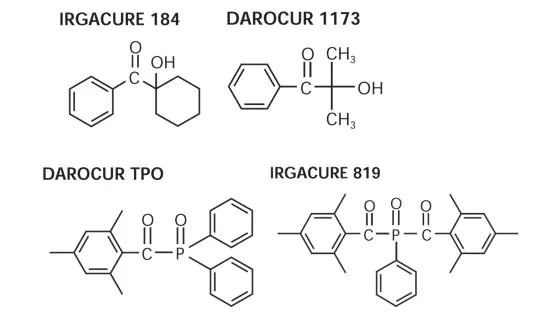
实验中使用的固化设备是 Oriel 100 瓦汞灯(发射光谱如图 2 所示),薄膜厚度控制在 50 微米。
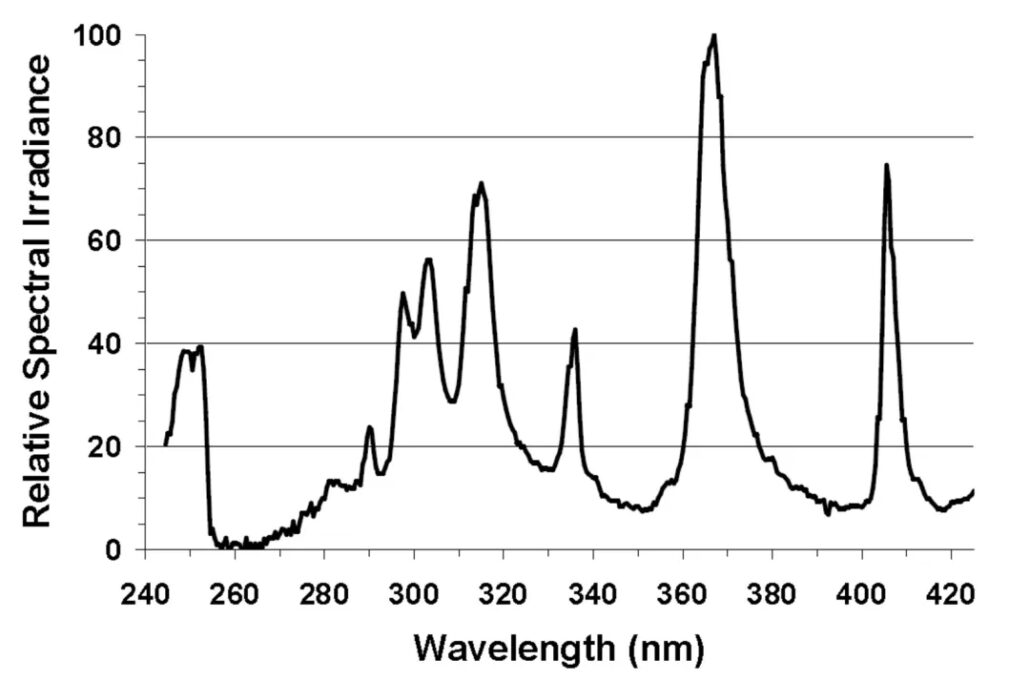
固化程度是通过傅立叶变换红外光谱(FTIR)来监测 810cm-1 处丙烯酸酯不饱和双键特征吸收峰的变化。750-780cm-1 波段也被用作参考峰,因为它在整个光固化过程中不会发生变化。
双键转换率(反应丙烯酸酯不饱和度,RAU)的计算公式为

地点 RL 是液态下丙烯酸酯双键吸收峰与参考峰的比率;以及 RC 是紫外线固化后丙烯酸酯双键吸收峰与参考峰的比值。

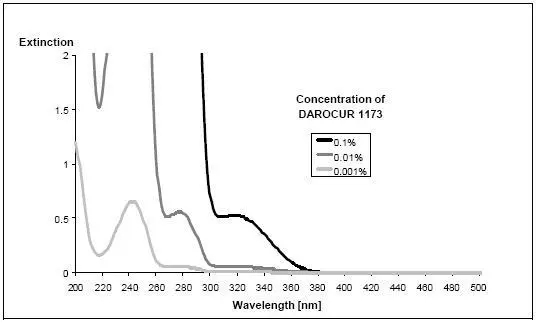

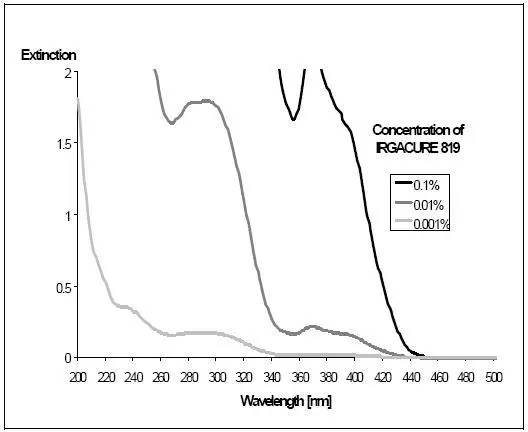
HCPK (光引发剂 184)的主要吸收波长范围为 240-250nm,吸收峰在 320-335nm 范围内。另一种羟基酮类光引发剂 HMPP(Darocur 1173)在 320-335 纳米波长范围内也有类似的吸收,峰值在 265-280 纳米波长处。仅使用这两种光引发剂的组合,就可以开始更好地利用紫外灯的输出(图 2)。
TPO 和 BAPO(光引发剂 819)的光谱与前两者有明显不同,光引发剂 TPO 在 360-395 纳米范围内有较强的吸收,而 BAPO 在 360-410 纳米范围内有较强的吸收。添加后两种光引发剂可以更好地利用汞灯的另外两个主要波段 370 纳米和 408 纳米。
在第一次实验中,使用相同量(重量比)的 184 和复合光引发剂进行比较。在相同能量(4.5mJ/cm2)的紫外线照射下,使用 184 的配方的双键转换率为 24.8%,而复合光引发剂配方的双键转换率高达 79.6%。

第二个实验是使用 6% 的 184 和复合光引发剂,在 4.5mJ/cm2 的辐照能量下,前者的双键转化率为 18.9%,而后者高达 67.2%。两者的差异非常明显。

第三次实验分别使用了 4% 184 和 3% 复合光引发剂,这说明使用复合光引发剂的后一种配方使用的光引发剂用量较少。在相同的辐照能量(4.5mJ/cm2)下,前者的双键转化率为 50.9%,而后者的双键转化率为 66.8%,前者的双键转化率更高。

第四次实验分别使用了 6% 184 和 4.5% 复合光引发剂。当辐射能量不变(4.5mJ/cm2)时,前者的双键转化率为 58.3%,后者的双键转化率为 67.9%。第三和第四次实验表明,复合光引发剂的配方即使用量较少,双键转化率也会更高。
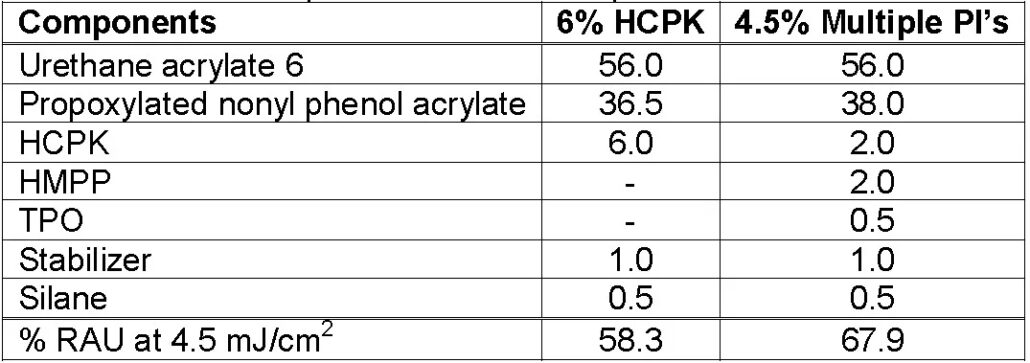
实验结果表明,使用复合光引发剂可以大大提高光引发剂的引发效率。虽然上述实验仅以一种光引发剂(光引发剂 184)为参照物进行比较,照射设备也仅使用汞灯,但实验结果也充分说明了复合光引发剂的优势。
我们知道,配方中使用光引发剂并不是越多越好,因为光引发剂过多会吸收紫外线,大大影响深层固化时紫外线的穿透效率,从而影响固化深度。
使用这种复合光引发剂不仅可以降低配方成本,还能实现更好的深度固化,减少光引发剂残留,降低成本。
立即联系我们!
如果您需要价格,请在下表中填写您的联系信息,我们通常会在 24 小时内与您联系。您也可以给我发电子邮件 info@longchangchemical.com 请在工作时间(UTC+8 周一至周六,上午 8:30 至下午 6:00)或使用网站即时聊天工具获得及时回复。
| 光引发剂 TPO | 化学文摘社编号 75980-60-8 |
| 光引发剂 TMO | cas 270586-78-2 |
| 光引发剂 PD-01 | 化学文摘社编号 579-07-7 |
| 光引发剂 PBZ | 化学文摘社编号 2128-93-0 |
| 光引发剂 OXE-02 | cas 478556-66-0 |
| 光引发剂 OMBB | 化学文摘社 606-28-0 |
| 光引发剂 MPBZ (6012) | CAS 86428-83-3 |
| 光引发剂 MBP | 化学文摘社编号 134-84-9 |
| 光引发剂 MBF | 化学文摘社编号 15206-55-0 |
| 光引发剂 LAP | 化学文摘社编号 85073-19-4 |
| 光引发剂 ITX | CAS 5495-84-1 |
| 光引发剂 EMK | 化学文摘社编号 90-93-7 |
| 光引发剂 EHA | 化学文摘社编号 21245-02-3 |
| 光引发剂 EDB | CAS 10287-53-3 |
| 光引发剂 DETX | 化学文摘社编号 82799-44-8 |
| 光引发剂 CQ / 樟脑醌 | 化学文摘社编号 10373-78-1 |
| 光引发剂 CBP | 化学文摘社编号 134-85-0 |
| 光引发剂 BP / 二苯甲酮 | 化学文摘社编号 119-61-9 |
| 光引发剂 BMS | 化学文摘社 83846-85-9 |
| 光引发剂 938 | 化学文摘社编号 61358-25-6 |
| 光引发剂 937 | CAS 71786-70-4 |
| 光引发剂 819 DW | cas 162881-26-7 |
| 光引发剂 819 | cas 162881-26-7 |
| 光引发剂 784 | cas 125051-32-3 |
| 光引发剂 754 | CAS 211510-16-6 442536-99-4 |
| 光引发剂 6993 | 化学文摘社编号 71449-78-0 |
| 光引发剂 6976 | cas 71449-78-0 89452-37-9 108-32-7 |
| 光引发剂 379 | cas 119344-86-4 |
| 光引发剂 369 | cas 119313-12-1 |
| 光引发剂 160 | 化学文摘社编号 71868-15-0 |
| 光引发剂 1206 | |
| 光引发剂 1173 | 化学文摘社编号 7473-98-5 |
